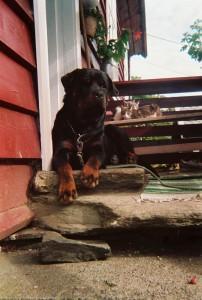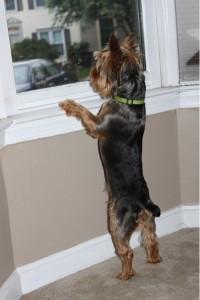 Dogs are very loyal and protective animals, and they have helped humans by serving as watch and guard dogs for many thousands of years.
Dogs are very loyal and protective animals, and they have helped humans by serving as watch and guard dogs for many thousands of years.
The ancient Roman poet Virgil wrote about watchdogs in the Georgics, a four-book poem that was published in 29 BC. Describing breeds such as Molossians and Laconians, dogs which were used to protect property and livestock, Virgil said: “Never, with them on guard, need you fear for your stalls a midnight thief, or onslaught of wolves, or Iberian brigands at your back”
The Lhasa Apso is one of the oldest recognized breeds of dog in the world, originating in Malaysia over 4,000 years ago. It was also known as the ‘Bark Lion Sentinel Dog’, and helped watch over the homes of nobility and Buddhist monasteries in Tibet around 800 years ago.
Another dog historically renowned for its abilities as a watchdog is the Belgian Schipperke, a breed originating in the early 16th century. Schipperkes are formidable barkers and a Belgian writing in 1882 testified to their effectiveness as watchdogs: “An indefatigable watchdog…as soon as he observes anything amiss he warns his master by his piercing barks.”
Many other breeds of canine make excellent watchdogs. Those best suited to the role are dogs which have been bred for territorial activity – including Terriers like the Airedale, Boston, and Cairn. Poodles and Spaniels also have the right temperament for watchdog duty. Such dogs are very alert and when they notice unusual activity they will bark vigorously –obviously desirable qualities in a watchdog.
Dogs with calmer and less reactive temperaments, such as Newfoundlands and Bloodhounds, are less effective as watchdogs. Excitable dogs too are not well suited to the role. Border Collies and Australian Shepherds tend to be excitable breeds, and they are much better suited to herding livestock than acting as watchdogs.

Large thick-coated livestock guardians such as the Komondor make excellent guard dogs, as do large short-coated bull and mastiff type dogs. Breeds such as the Rottweiler, the Bullmastiff, the Doberman Pinscher and the German Shepherd all make excellent guard dogs.
Whilst physically imposing breeds are today favored as guard dogs, smaller dogs too have historically been used in this role. Airedale Terriers were used during both the First and Second World Wars, as messengers, scouts, sentries, sled dogs, and guard dogs.
Traditionally, intimidating guard dogs have been deployed alongside alert and noisy watchdogs to provide a highly effective property security system. When the watchdog senses suspicious activity it acts as an alarm, alerting the more powerful and imposing guard dog which moves in to aggressively deter and repel any intruders.
It’s important to remember that guard dogs can be very dangerous, and an owner will be held criminally responsible should they have allowed their dog to run free and it attacks someone. Such dogs require special training and handling, and great caution should be taken before buying a canine with the intention of using it as a guard dog.
Watchdogs on the other hand can provide great reassurance to security-conscious home and business owners, as well as providing a lifetime of loyalty and companionship.
~This guest post was written by animal lover Brit Peacock on behalf of UK home security experts The Safe Shop.
Tags: dog breed, dog instinct, guard dog, protection dog, watch dog
